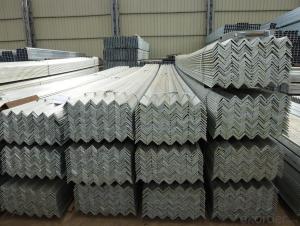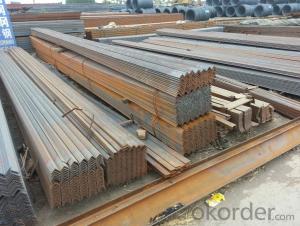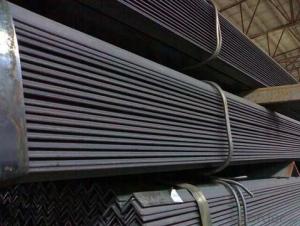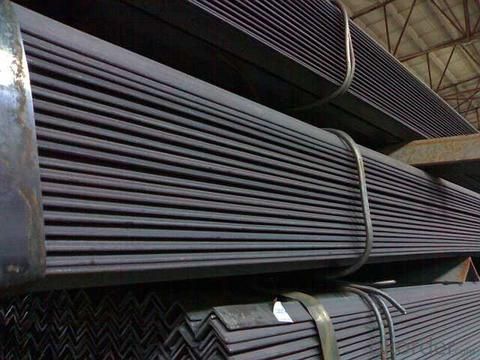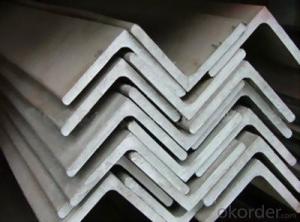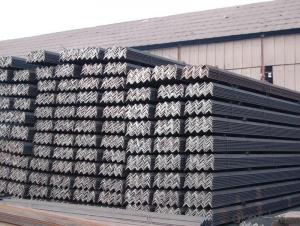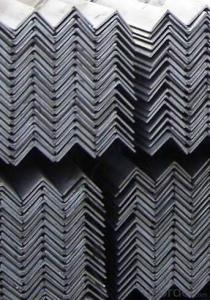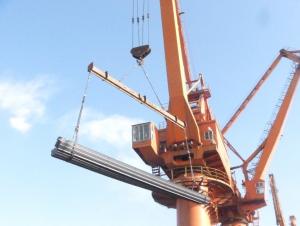SS400 Material High Quality Angle Bar
- Loading Port:
- Tianjin
- Payment Terms:
- TT or LC
- Min Order Qty:
- 25 m.t.
- Supply Capability:
- 2000 m.t./month
OKorder Service Pledge
OKorder Financial Service
You Might Also Like
Product Description:
OKorder is offering Angle Steel great prices with worldwide shipping. Our supplier is a world-class manufacturer of steel, with our products utilized the world over. OKorder annually supplies products to European, North American and Asian markets. We provide quotations within 24 hours of receiving an inquiry and guarantee competitive prices.
Product Applications:
According to the needs of different structures, Angle can compose to different force support component, and also can be the connections between components. It is widely used in various building structures and engineering structures such as roof beams, bridges, transmission towers, hoisting machinery and transport machinery, ships, industrial furnaces, reaction tower, container frame and warehouse etc.
Product Advantages:
OKorder's Angle Steelare durable, strong, and resist corrosion.
Main Product Features:
· Premium quality
· Prompt delivery & seaworthy packing (30 days after receiving deposit)
· Corrosion resistance
· Can be recycled and reused
· Mill test certification
· Professional Service
· Competitive pricing
Product Specifications:
1. Invoicing on theoretical weight or actual weight as customer request
2. Length: 6m, 9m, 12m as following table
3. Sizes
Sizes: 25mm-250mm | ||
a*t | ||
25*2.5-4.0 | 70*6.0-9.0 | 130*9.0-15 |
30*2.5-6.6 | 75*6.0-9.0 | 140*10-14 |
36*3.0-5.0 | 80*5.0-10 | 150*10-20 |
38*2.3-6.0 | 90*7.0-10 | 160*10-16 |
40*3.0-5.0 | 100*6.0-12 | 175*12-15 |
45*4.0-6.0 | 110*8.0-10 | 180*12-18 |
50*4.0-6.0 | 120*6.0-15 | 200*14-25 |
60*4.0-8.0 | 125*8.0-14 | 250*25 |
Alloy No | Grade | Element (%) | |||||
C | Mn | S | P | Si | |||
|
|
|
|
|
|
| |
Q235 | B | 0.12—0.20 | 0.3—0.7 | ≤0.045 | ≤0.045 | ≤0.3 | |
|
|
|
|
|
|
| |
Alloy No | Grade | Yielding strength point( Mpa) | |||||
Thickness (mm) | |||||||
≤16 | >16--40 | >40--60 | >60--100 | ||||
≥ | |||||||
|
|
|
|
|
| ||
Q235 | B | 235 | 225 | 215 | 205 | ||
Alloy No | Grade | Tensile strength (Mpa) | Elongation after fracture (%) | ||||
Thickness (mm) | |||||||
| ≤16 | >16--40 | >40--60 | >60--100 | |||
≥ | |||||||
|
|
|
|
|
|
| |
Q235 | B | 375--500 | 26 | 25 | 24 | 23 | |
Packaging & Delivery of Angle Bar
Packaging Detail: All goods are packed in bundle with steel strips and shipped by break bulk vessel or container (depend on target market and different ports)
Delivery Detail: 45 days
Trade terms: FOB, CFR, CIF
Payment:
-Invoicing on theoretical weight or actual weight as customer’s request.
-FOB, CFR or CIF.
-Regular terms of payment:
1, 30% payment in advance, the remaining balance (70% payment) against the copy of B/L. 100% payment before shipment.
2, 30% payment in advance, the remaining balance (70% L/C) against the copy of B/L. 100% payment before shipment.
3, Negotiable.
FAQ:
Q1 How soon can we receive the product after purchase?
A1 Within three days of placing an order, we will begin production. The specific shipping date is dependent upon international and government factors, but is typically 7 to 10 workdays.
Q2: How do we guarantee the quality of our products?
A2: We have established an advanced quality management system which conducts strict quality tests at every step, from raw materials to the final product. At the same time, we provide extensive follow-up service assurances as required.
Q3: How soon can we receive the product after purchase?
A3: Within three days of placing an order, we will begin production. The specific shipping date is dependent upon international and government factors, but is typically 7 to 10 workdays.
Images:
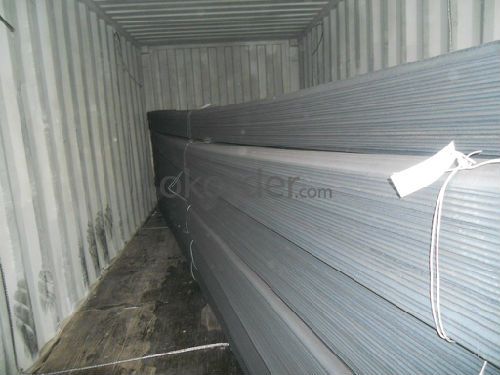
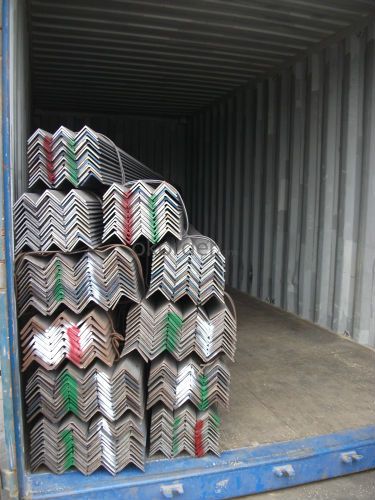
- Q: Can steel angles be used for reinforcing steel structures?
- Steel angles are capable of reinforcing steel structures. Their versatility and widespread use in construction projects stem from their strength and durability. Steel angles serve as reinforcements to fortify and provide additional support to steel structures including beams, columns, and trusses. To enhance the overall structural integrity of steel structures, steel angles are often used in conjunction with other reinforcing materials such as steel bars or mesh. The angle shape of steel angles facilitates easy welding or bolting, making them a popular choice for reinforcing steel structures. Moreover, steel angles are available in various sizes and thicknesses, offering flexibility in design and application. All in all, steel angles prove to be an effective and commonly employed option for reinforcing steel structures.
- Q: Can steel angles be used in the construction of agricultural buildings?
- Yes, steel angles can be used in the construction of agricultural buildings. Steel angles are commonly used as structural components for framing, bracing, and supporting various elements in agricultural buildings such as walls, roofs, and machinery. They provide strength, stability, and durability, making them suitable for withstanding the load and environmental conditions typically encountered in agricultural settings.
- Q: What material is angle iron?
- Angle called angle, the steel strip is perpendicular to each other on both sides into the corner. There are equal angles and unequal angles. The two sides of an equal angle steel are equal in width.
- Q: Can steel angles be used in the construction of staircases?
- Yes, steel angles can be used in the construction of staircases. Steel angles provide structural support and stability, making them a suitable choice for building staircases.
- Q: Can steel angles be used in electrical grounding applications?
- Yes, steel angles can be used in electrical grounding applications. Steel angles are commonly used in construction for their strength and durability. In electrical grounding applications, steel angles can be used to create grounding grids or grounding systems. These grids or systems help to prevent electrical shock hazards by providing a low-resistance path for electrical currents to flow to the ground. Steel angles are often used as structural components in these grounding systems due to their ability to withstand physical stress and their conductive properties. However, it is important to ensure that the steel angles are properly installed and connected to the electrical system in accordance with relevant codes and standards to ensure effective grounding and safety.
- Q: How do steel angles perform in corrosive or acidic environments?
- Steel angles perform well in corrosive or acidic environments due to their inherent resistance to corrosion. The presence of alloying elements, such as chromium and nickel, in stainless steel angles enhances their corrosion resistance, making them suitable for such environments. Additionally, a protective oxide layer forms on their surface, providing further protection against corrosive elements.
- Q: What are the typical lifespan and durability of steel angles?
- The lifespan and durability of steel angles can differ based on a range of factors, including the quality of the steel, the environment they are used in, and the level of maintenance they receive. However, steel angles are renowned for their exceptional durability and extensive lifespan. Generally, steel angles are engineered to bear heavy loads and provide structural support in various construction and industrial settings. They are typically crafted from either carbon steel or stainless steel, both of which are recognized for their strength and resistance to corrosion. With proper maintenance and protection against corrosion, steel angles can remain in good condition for many decades without significant deterioration. Regular maintenance practices such as cleaning, painting, and applying protective coatings can further extend their lifespan. The durability of steel angles is also influenced by the installation environment. In harsh environments with high levels of moisture, extreme temperatures, or exposure to chemicals, the lifespan may be shorter. However, implementing effective corrosion protection measures can mitigate these effects and ensure a longer lifespan. It is important to note that steel angles used in marine or offshore applications may have a shorter lifespan compared to those used in less corrosive environments. This is primarily due to continuous exposure to saltwater and severe weather conditions, which can expedite corrosion. To summarize, steel angles are renowned for their durability and can have a long lifespan if adequately maintained and protected against corrosion. However, the specific lifespan may vary depending on factors such as the steel quality, environmental conditions, and maintenance practices.
- Q: Can steel angles be used for reinforcement bars?
- No, steel angles cannot be used as reinforcement bars. Reinforcement bars are typically made of plain or deformed steel bars that are designed specifically for providing strength and stability to concrete structures. Steel angles, on the other hand, are primarily used for structural support or framing purposes and are not suitable for use as reinforcement bars.
- Q: How do you calculate the slenderness ratio of a steel angle?
- To calculate the slenderness ratio of a steel angle, you need to determine the length and the moment of inertia of the angle section. The slenderness ratio is a measure of how slender or slender a member is, and it helps in determining its stability and ability to resist buckling. First, measure the length of the steel angle, which is the distance between its two ends. This length should be measured in the same unit as the dimensions of the angle section. Next, calculate the moment of inertia of the steel angle section. The moment of inertia is a measure of the section's resistance to bending and is typically denoted by the symbol "I". It depends on the dimensions of the angle section and can be obtained from reference tables or calculated using mathematical formulas. Once you have the length and moment of inertia of the steel angle, you can calculate the slenderness ratio using the formula: Slenderness ratio = (Length of angle) / (√(Moment of inertia)) Make sure the length and moment of inertia are expressed in the same unit before performing the calculation. The resulting slenderness ratio will be a dimensionless value. It is important to note that the slenderness ratio is used to determine the appropriate design criteria and allowable loads for the steel angle. Different design codes or standards may have specific limits or guidelines for the maximum slenderness ratio that can be used safely in different applications. Therefore, it is crucial to consult the relevant design codes or seek professional engineering advice to ensure the correct and safe use of the steel angle.
- Q: What is the cost of steel angles compared to other materials?
- The cost of steel angles compared to other materials can vary depending on various factors such as the type and grade of steel, market conditions, and availability. However, in general, steel angles tend to be a cost-effective option when compared to other materials commonly used for structural or construction purposes. Steel angles are widely used in various industries including construction, manufacturing, and infrastructure due to their durability, strength, and versatility. Compared to materials like aluminum or stainless steel, steel angles are often more affordable. This is because steel is a widely available material and can be produced in large quantities, leading to cost efficiencies in manufacturing processes. Additionally, steel angles have a long lifespan and require minimal maintenance, further contributing to their cost-effectiveness over time. They also offer excellent load-bearing capabilities, making them suitable for a wide range of applications, including building frames, support structures, and machinery. However, it is important to note that the cost of steel angles can still vary depending on the specific requirements and specifications of a project. Factors such as size, length, thickness, and any additional treatments or finishes can influence the price. Therefore, it is advisable to consult with suppliers or manufacturers to obtain accurate and up-to-date pricing information based on individual project needs.
Send your message to us
SS400 Material High Quality Angle Bar
- Loading Port:
- Tianjin
- Payment Terms:
- TT or LC
- Min Order Qty:
- 25 m.t.
- Supply Capability:
- 2000 m.t./month
OKorder Service Pledge
OKorder Financial Service
Similar products
Hot products
Hot Searches
